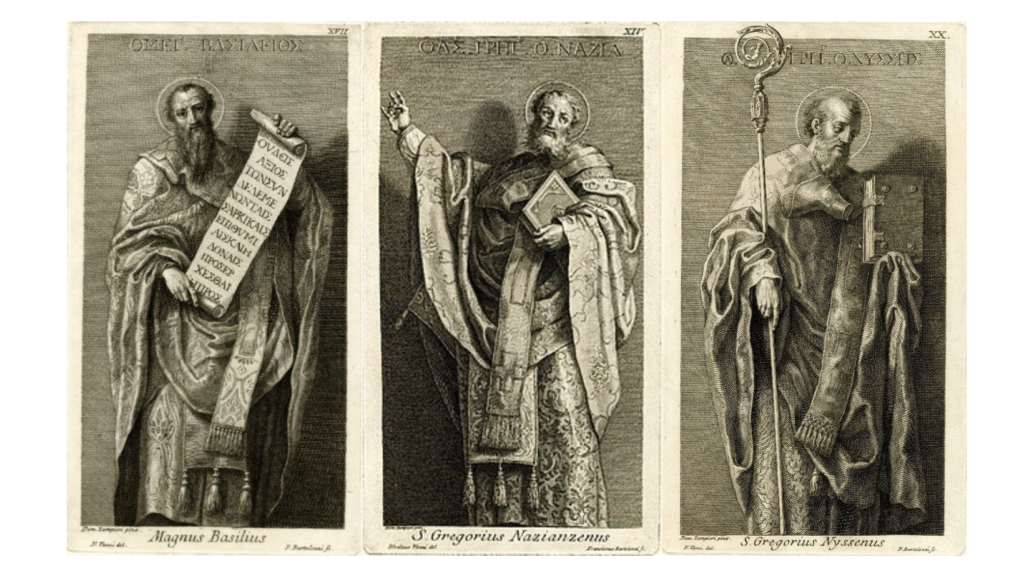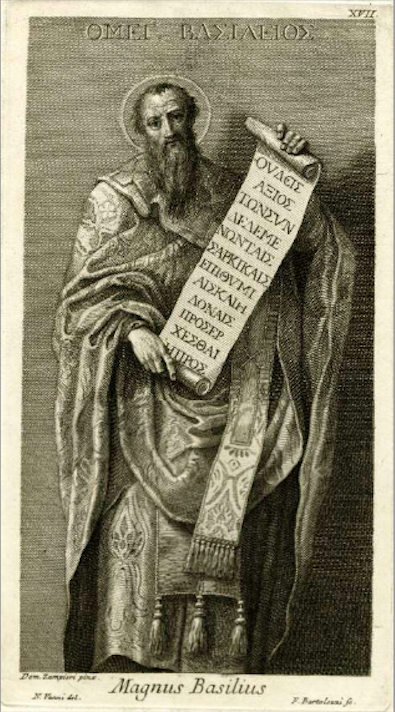
The Cappadocian Fathers
In the Lutheran Church, January 10th marks the day set aside to remember Ss. Basil the Great, Gregory of Nazianzus, and Gregory of Nyssa—bishops of the early church who became known as “Cappadocian fathers” and men who were tied together as friends and family.
Saint Basil the Great

Basil was born AD 329 in Caesarea (in the region of Cappadocia, Turkey) to a devout Christian family that included ten children, three of whom became bishops. His younger brother, Gregory of Nyssa, was one of these. His father was a pious man, and his mother and at least one sister, Macrina, were likewise so pious that they both joined a monastic community later in life. Educated in rhetoric and philosophy in Caesarea, Constantinople, and Athens at a young age, Basil enjoyed university life. It was at the university that he became close to Gregory of Nazianzus during the early years of his studies.
After his schooling concluded, Basil traveled all over the East and even joined a monastic community with his friend Gregory for about five years. After a time, he was ordained a deacon in Antioch and later a priest in Caesarea. Eventually, however, the Church would endow him with even greater responsibilities. Euseubius, the bishop of Caesarea, died in the 370s, and Basil was chosen as his successor. He was highly regarded and called upon to fight in the raging Arian controversy of the time. As he began to exercise his episcopal role in the Church, he also began to devote himself further to his own theological writings as well as the increased material care of his parishioners.
He spent his time focused on mainly practical concerns: preaching to large crowds; organizing a complex institution that cared for the sick and fed the hungry; and even built churches, hospitals, and hotels meant to serve those in need. With his high position in the Church, he depended on friends such as Gregory to go to churches and communities that were falling away from the faith and help reconcile their issues. Gregory later resented him for this, and their friendship became strained during the years when Basil held his high positions; however, they reconciled before death.
Many of Basil’s most prominent characteristics are revealed in his letters, of which the Church still has about 300. These correspondences distill his experiences and the ethical and social problems that he dealt with at the time and provide many short treatises on theology or ethics that have been instrumental to the Church’s theology at large. Basil died January 1, 379.
Saint Gregory of Nazianzus

The first of our two “Gregorys,” Gregory of Nazianzus, was also born to a prominent Christian family around AD 330. His father was a bishop, also named Gregory. Extremely studious by nature, Gregory befriended Basil while they were students and later joined Basil in the monastic life.
In 362 Gregory was ordained as a priest and worked in Nazianzus supporting Basil, who called on him to help with struggling churches and the Church’s struggle with the Arians. It was when Basil became archbishop that he placed Gregory in various positions and installed him as the bishop of Nazianzus.
However, in many ways, Gregory’s role in the church was defined more in relation to his father, who forcibly ordained him in 328. Beyond his service to his father’s congregation in Nazianzus, Gregory was appointed bishop of Constantinople in 379 in an effort to “resurrect” Nicene orthodoxy in the empire. From that position, he delivered five important lectures (the Five Theological Orations) which remain a classic expression of Nicene trinitarian theology and earned him the title “Gregory the Theologian.” He was also the first presiding bishop of the Council of Constantinople (381), and faithfully confessed the full divinity of the Holy Spirit despite great opposing pressure.
After the council, he remained influential primarily through his writings, which include two important “Letters to Cledonius” on the person of Christ. One of these letters contains the well-known confession, “what was not assumed is not redeemed,” meaning that Jesus became a complete human being so that human beings, body and soul, would be saved. He lived out the life of monasticism and writing for the rest of his days, a lifestyle he favored.
After Basil’s death, Gregory retreated from his prominent position in the Church to live a quiet life on his family property, where he was known to enjoy gardening and the private study of Scripture. He died there on January 25, 389.
Saint Gregory of Nyssa

The second of the “Gregorys” that are commemorated by the Lutheran Church on January 10th is St. Gregory of Nyssa, St. Basil’s younger brother. Gregory was born around AD 335 and grew up to be a scholar, writing various theological and monastic works that reflected the philosophical and Christian trends of the time.
His thinking was deeply influenced by his brother, Basil and their friend, Gregory of Nazianzus. Although he started out his adult life as a teacher of rhetoric, he eventually focused his efforts mainly on religious studies and Christian devotion.
In 372 he was ordained and later consecrated as bishop of Nyssa, a small city over which Basil had appointed him. However, his negative relations with the Arians eventually caused Gregory to be deposed and banished from the Church. He was later asked to return to his congregation, and it was there that he not only kept his people as part of the broader Christian Church but also became known as one of the leading theologians who successfully struggled against the Arians.
All throughout his life Gregory considered himself first and foremost a scholar. He spent much of his time articulating the Fathers’ theology regarding the Trinity and discussing other important issues of the Church such as baptism, usury, and the importance of parishioners’ devotional lives. While Gregory’s theological legacy is less well known than Basil or Gregory of Nazianzus, his work as a scholar and writer has endured the test of time and has been resurrected in recent years. He died in 394, around 15 years after his brother and 5 years after their friend.
A Brief History
Together, these three saints had such an incredible impact on the Church and her theology that it is hard to overstate the influence they have had on our faith and the Christian life. They defined for us what it means that God is triune and articulated how Jesus is both fully God and fully man. It is also to these men that we owe the words in the creed that the Holy Spirit “proceeds” from the Father and Son.
This profound theological influence is largely the result of the men’s involvement in the Arian controversy, a struggle in which the Church was involved for more than a century. While Arianism is named after Arius, a third- and fourth-century priest in Alexandria, its proponents were spread throughout the Roman Empire and beyond. These Arians denied the full divinity of God the Son, asserting that he was a created being of a lesser substance than God the Father, and similarly denied the full divinity of the Holy Spirit. This false teaching was quite popular in the days of Ss. Basil, Gregory, and Gregory, so the three men devoted much of their time to explaining the proper teaching of the Trinity, using words and expressions to do so that are still considered crucial to the Church’s doctrinal heritage.
While these men have had various feast days attributed to them over the course of the Church’s history, the Lutheran Church has put them together on January 10th, which lands in the middle of their older Western feast date on January 2nd and their Eastern feast dates of January 1st and 25th/30th respectively. Celebrated collectively, the Church recognizes them as champions of the early faith and staunch defenders of Trinitarian orthodoxy.

Collect
Grant, We beseech Thee, O Almighty God: that the solemn feast of Blessed Basil, Gregory, and Gregory, Thy Confessors and Bishops, may both increase our devotion and further our salvation through the reception of your grace; through Jesus Christ, our Lord, who liveth and reigneth with Thee and the Holy Ghost: ever one God, world without end. Amen.
Lessons
Resources
Issues, Etc. interview with the Rev. Dr. Bill Weinrich on the Cappadocian Fathers: Basil, Gregory of Nyssa and Gregory of Nazianzus
Issues, Etc. interview with the Rev. Dr. James Bushur on the Cappadocian Fathers: Basil the Great, Grergory of Nazianzus, Gregory of Nissa
Propers found in Daily Divine Service Book: A Lutheran Daily Missal, edited by the Rev. Heath Curtis
References:
1. Voragine, Jacobus de. The Golden Legend: Reading on the Saints. Vol. 1. Translated by William Granger Ryan. Princeton Press. 1993.
2. Voragine, Jacobus de. The Golden Legend: Reading on the Saints. Vol. 2. Translated by William Granger Ryan. Princeton Press. 1993.
3. Weedon, William. Celebrating the Saints. Concordia Publishing House. 2016.
Images:
1. St. Basil the Great, Francesco Bartolozzi, Italy, 1762.
2. St. Gregory of Nazianzus, Francesco Bartolozzi, Italy, 1762.
3. St. Gregory of Nyssa, Francesco Bartolozzi, Italy, 1762.
4. Three Saintly Friends, Dmitry Shkolnik, Russia, c. 2000s.
Some links might be affiliate links which means we may receive a small commission at no extra cost to you. As an Amazon Associate we earn from qualifying purchases.




[…] 10th marks the day on which we commemorate three of the most influential early Church Fathers: Ss. Basil the Great, Gregory of Nazianzus, and Gregory of Nyssa. It is a compromise insofar as this date lies in between the days on which they have historically […]